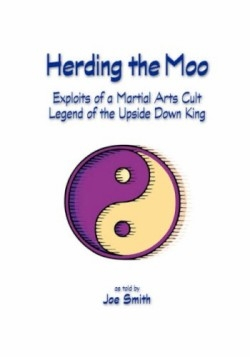Herding the Moo
Exploits of a Martial Arts Cult Legend of the Upside Down King
This book provides fascinating insight into the notorious Chung Moo Doe (a.k.a. Chung Moo Quan Oom Yung Doe etc.) martial arts cult founded by John C. Kim (a.k.a. Chull Kim Jack Park or “Iron” Kim). Although the group was exposed in the CBS investigative report The Cult and the Con in the late 1980s as well as in the article “Cult of the Quan” in Martial Arts Professional magazine the organization still exists today. Having served time for tax evasion and conspiracy the founder and thirteen members of his inner circle have already been released from prison. No doubt fearing repercussions the author writes under the penname Joe Smith.
“Smith” explains how he was taken in by the “True Right and Correct” teachings of a narcissistic sociopath. He sold his new Oldsmobile Cutlass drove away his friends gave up on his college education changed jobs and ultimately spent tens of thousands of dollars to earn a nearly meaningless black belt and become an instructor in the cult’s system. Eventually he became disillusioned with the group developed the fortitude to pull himself away from their teachings got his life in order and wrote about his experiences.
While the author’s writing is a bit uneven and (understandably) overly vitriolic at times there is nothing a good editor couldn’t fix straightaway. His story is interesting and important. Packed with riveting vignettes of cult life this cautionary tale is one that all devoted martial artists and aspiring practitioners ought to read.
The book elucidates why otherwise intelligent people would join a cult. Often it’s because the group fulfils and/or exploits deep-seated psychological needs that victims may not even be aware of. Aspiring martial artists can become particularly vulnerable to such manipulations since they often approach the arts with little foreknowledge save for the ubiquitous Hollywood fantasies they watch on the silver screen. Expecting to find mysterious Asian rituals eager practitioners hear plausible legends and see bogus displays of fighting prowess. This chicanery reinforces their predispositions. Even legitimate martial artists wear distinctive uniforms associate with like-minded individuals and perform activities that are nearly unfathomable to the uninitiated. Cult leaders selfishly twist the conventions and hook victims with the promise of inimitability status and power and the pull to join and stay in the cult becomes very strong indeed.
As the author so aptly states it’s a slow process like the boiled frog analogy. Put a frog in warm water and he’s happy. Increase the temperature slowly and he’ll stay in trying to continually adapt. Turn up the heat too high throw too much cultness at him at once however and he’ll hop out and leave maybe telling other frogs not to go near the cult’s pot. So the smart effective cult leader slowly raises the temperature and waits until his victims have adjusted. Then after the new norm has been established he further refines the cognitive dissonance so it doesn’t seem all that bad. What was once intolerable now becomes acceptable. Victims reinforce their new beliefs while the cult insidiously takes over their lives.
Reviewed by
Lawrence Kane
Disclosure: This article is not an endorsement, but a review. The publisher of this book provided free copies of the book and paid a small fee to have their book reviewed by a professional reviewer. Foreword Reviews and Clarion Reviews make no guarantee that the publisher will receive a positive review. Foreword Magazine, Inc. is disclosing this in accordance with the Federal Trade Commission’s 16 CFR, Part 255.

